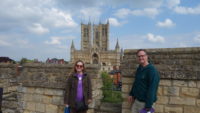 Sometimes a place has so much history that if you have just one day to see it all, you can only dip your toe in the shallow end. Such was today, especially since most things in Lincoln close down at 5:00 even in the summer.
Sometimes a place has so much history that if you have just one day to see it all, you can only dip your toe in the shallow end. Such was today, especially since most things in Lincoln close down at 5:00 even in the summer.
Dubbs met us at out hotel for breakfast, and then we drove out the couple of miles to the International Bomber Command Centre. The IBCC is a memorial to the bomber crews and support staff who were based in Lincoln County, which held twenty-seven airfields for bombers. The IBCC only opened in 2018, and so the museum and memorial make good use of modern design.
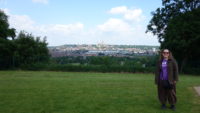 We joined a tour of the grounds, which took us to the front memorial commemorating Operation Manna, in which the British dropped thousands of tons of food to starving civilians in the Netherlands in the winter of 1944-45. We then wrapped around to the side of the building to see the peace gardens planted with plants from all the continents that served with the RAF (all six habitable continents and more than fifty countries). The guide took us to a lime tree grove where there was a tree planted in the relative location (compared to the other trees) of each air base in the county. I thought the trees were lime trees because of the nickname for the British (“limeys”), but the guide said they were hardy and didn’t grow so tall as to obscure the Spire, which is the main memorial to the air crews who died in service.
We joined a tour of the grounds, which took us to the front memorial commemorating Operation Manna, in which the British dropped thousands of tons of food to starving civilians in the Netherlands in the winter of 1944-45. We then wrapped around to the side of the building to see the peace gardens planted with plants from all the continents that served with the RAF (all six habitable continents and more than fifty countries). The guide took us to a lime tree grove where there was a tree planted in the relative location (compared to the other trees) of each air base in the county. I thought the trees were lime trees because of the nickname for the British (“limeys”), but the guide said they were hardy and didn’t grow so tall as to obscure the Spire, which is the main memorial to the air crews who died in service.
 The Spire is a tall airfoil-shaped piece of steel that is as tall as the wingspan of a Lancaster bomber (102 feet tall). It’s on the top of a hill opposite of the Lincoln Cathedral, and is surrounded by steel plates with the names of all the men (and one woman) who died flying on a bomber cut out of the plates. There is also a sculpture of an air crew who died on the Dambuster mission in 1943 that is silhouetted against the sky and cathedral, which is very moving.
The Spire is a tall airfoil-shaped piece of steel that is as tall as the wingspan of a Lancaster bomber (102 feet tall). It’s on the top of a hill opposite of the Lincoln Cathedral, and is surrounded by steel plates with the names of all the men (and one woman) who died flying on a bomber cut out of the plates. There is also a sculpture of an air crew who died on the Dambuster mission in 1943 that is silhouetted against the sky and cathedral, which is very moving.
Meredith and I then headed in to the museum to a prestation room (Dubbs had to do something school-related). In the room, we played the part of members of aircrews as we were briefed on our mission on June 5th, 1944, for Operation Taxable (as part of the D-Day landings). We received precise navigation and meteorological reports, and got our orders to fly in circles over half the English Channel, dropping “window” – strips of aluminum which would scramble German radar. Because it made radar useless and the strips drifted toward Calais and away from Normandy, it made the Germans think something major was moving toward Calais. The presentation was fitting, as today was the eightieth anniversary of D-Day.
We met back up with Dubbs and Candice for the small but excellent museum. There is a small theater showing films about the bombers and crews, and a room-spanning placard series showing twenty-four hours in the life of a bomber crew. There were multiple places where you could listen to crew and ground crew tell stories, and several films of people in uniform telling you how they worked and fought. Since one of the missions of the IBCC is for reconciliation, I saw a young German fighter pilot tell how he shot down a Lancaster, which was still somewhat hard for me to hear. It’s an important reminder that the vast majority of Germans were doing a job they were forced to do.
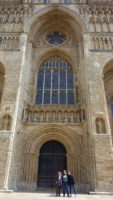 That wrapped up our quick overview of the IBCC. I could have spent more time there, but we needed to move on to Lincoln Cathedral. Candice had other commitments, so she left us there. Dubbs showed us a couple of tombs of some of her more royal relatives from way back, and we looked around the cathedral while waiting for a tour and trying to avoid the service for hundreds of school children in the main space. Meredith and I were very much amused at a stone placed in the floor that read something to the effect of “This stone is a temporary marker for so-and-so, died 1777.” I’m sure they are going to get the permanent marker in place any day now.
That wrapped up our quick overview of the IBCC. I could have spent more time there, but we needed to move on to Lincoln Cathedral. Candice had other commitments, so she left us there. Dubbs showed us a couple of tombs of some of her more royal relatives from way back, and we looked around the cathedral while waiting for a tour and trying to avoid the service for hundreds of school children in the main space. Meredith and I were very much amused at a stone placed in the floor that read something to the effect of “This stone is a temporary marker for so-and-so, died 1777.” I’m sure they are going to get the permanent marker in place any day now.
We met up with a tour guide at 2:00, and she took us outside so we could hear her since the school service had just ended. Some highlights from her tour:
– The cathedral was started just before 1100 and originally had a wooden roof that burned twice. When it was replaced with a stone roof, the walls collapsed forty years later “in an earthquake” from which no other buildings suffered.
– The rebuilt cathedral was going to be in one style, but ran out of money, so they kept the older facade.
– The inside and outside used to be very colorfully decorated, but the decorations were all destroyed by Cromwell and company.
– There was a “dole window” where poor pilgrims could knock and get enough money for a meal and lodging. Our guide intimated that this is the source of the expression “on the dole.”
– One of the large high-up stained glass windows is actually just full of old window shards reused in the new window. It’s quite pretty, and you can’t tell without binoculars that it’s reusing shards.
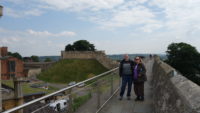 More touring! More history! Off we went to the Lincoln Castle, which still has intact walls. The inside of the walls contains a Victorian prison and a building that has been used as a judicial hall on and off over the centuries. But the walls are the real prize. You come up sixty-five steps to be greeted with a grand view of the cathedral. You are then allowed to circumnavigate the entire wall, including being able to go up the one existing tower. On a sunny day, it was pretty spectacular.
More touring! More history! Off we went to the Lincoln Castle, which still has intact walls. The inside of the walls contains a Victorian prison and a building that has been used as a judicial hall on and off over the centuries. But the walls are the real prize. You come up sixty-five steps to be greeted with a grand view of the cathedral. You are then allowed to circumnavigate the entire wall, including being able to go up the one existing tower. On a sunny day, it was pretty spectacular.
We went down to the vault area to see one of the three displayed copies of the Magna Carta (the others are one in the British Library and one in Salisbury Cathedral, both of which we have seen). We went down into the vault, and there it was! The last in our collect-them-all series! Boy, it sure looks to be in good shape! Why is the docent apologizing for the replica? It seems the real Magna Carta was taken away to an unknown secure location yesterday, so we missed it. We did get to see a good film on how the document came to be (near civil war with the king) and why it has been so important (the first document to limit a monarch with law).
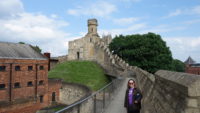 That ended the history tour for the day, as it was almost 5:00. We got a very good supper in the old quarter, got a quick tour from Dubbs of parts of the Roman wall that still exist in a few places, and then went down Steep Hill (it’s really called that) to a pub for a pub quiz (trivia). We met up with another of Dubbs’ friends and classmates, a fun young woman from India, and we whiled away a pleasant hour or so playing trivia. We came in second of four teams.
That ended the history tour for the day, as it was almost 5:00. We got a very good supper in the old quarter, got a quick tour from Dubbs of parts of the Roman wall that still exist in a few places, and then went down Steep Hill (it’s really called that) to a pub for a pub quiz (trivia). We met up with another of Dubbs’ friends and classmates, a fun young woman from India, and we whiled away a pleasant hour or so playing trivia. We came in second of four teams.
And so we said goodnight, and Mer and I headed back up Steep Hill to go to our hotel. Sometimes you have to work surprisingly hard to get to the shallow-end stuff.